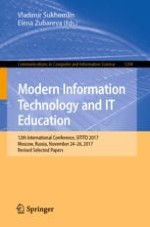2021 | Buch
Modern Information Technology and IT Education
12th International Conference, SITITO 2017, Moscow, Russia, November 24–26, 2017, Revised Selected Papers
herausgegeben von: Vladimir Sukhomlin, Elena Zubareva
Verlag: Springer International Publishing
Buchreihe : Communications in Computer and Information Science
